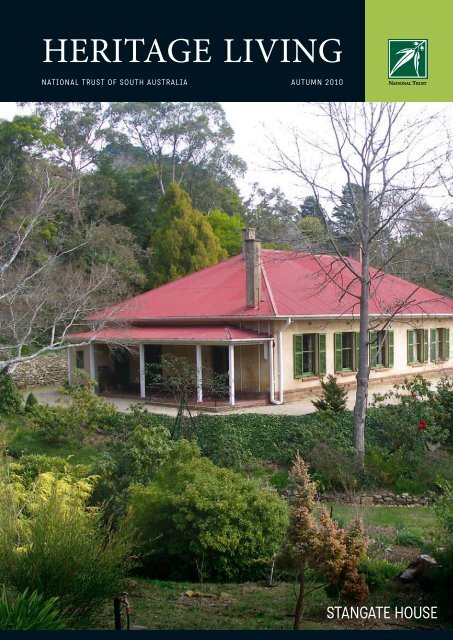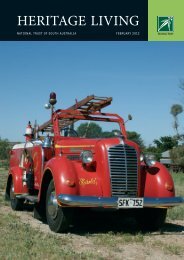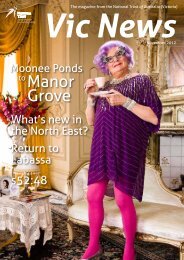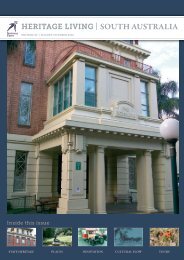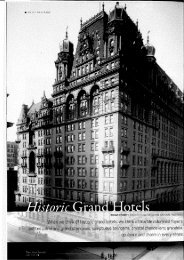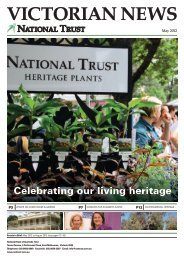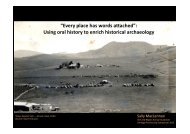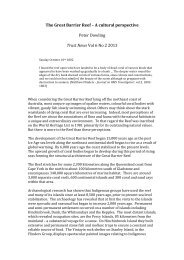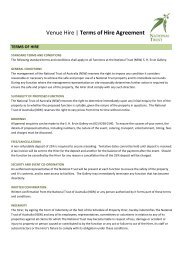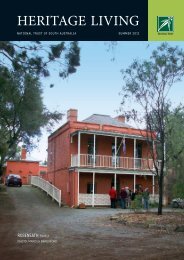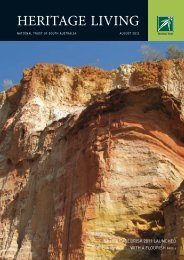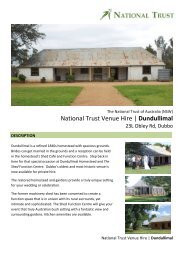HERITAGE LIVING - National Trust of Australia
HERITAGE LIVING - National Trust of Australia
HERITAGE LIVING - National Trust of Australia
Create successful ePaper yourself
Turn your PDF publications into a flip-book with our unique Google optimized e-Paper software.
Heritage Livingnational TRust <strong>of</strong> South <strong>Australia</strong> autumn 2010Stangate House
Heritage Livingnational TRust <strong>of</strong> South <strong>Australia</strong>Contents8 9 11 164 President’s Report4 CEO’s report5 stangate house6 trust news6 New acquisitions7 MOONTA CEMETERY7 book review8 Decision not tocentralise <strong>National</strong>Archives a big win8 Repairing salt dampin our properties9 SAFE GUARD YOURCOLLECTIONS10 Forum examinesfuture heritagepreservation11 <strong>HERITAGE</strong> LOST12 Provisional StateHeritage listing forthe Union HallRIGHT: John Knox Presbyterian Church.Photo Marcus Beresford.13 <strong>National</strong> <strong>Trust</strong> <strong>of</strong>South <strong>Australia</strong>:Increase tosubscription rates14 Advocacy:325 Wakefield Street16 Advocacy:Beresford Arms17 EventsHistoric village at Morphett Valean ongoing issueMarcus BeresfordThe once handsome John Knox Presbyterian Church (1856)and adjoining School (1870) at Morphett Vale have fallen intoa state <strong>of</strong> serious disrepair, despite being listed on the SA StateHeritage Register. Not only are the parapet walls <strong>of</strong> the churchdisintegrating, but the rear wall has a dangerous lean, theinterior floor has mostly disappeared, as have windows and other fittings.It is difficult to understand why these buildings have been allowed to get into such a bad state. A meetingbetween the owner, local Council and Heritage Branch in March 2009 suggested a feasibility study intorestoration <strong>of</strong> the building in conjunction with housing development on the land, but this has not occurred.In view <strong>of</strong> this longstanding issue the <strong>Trust</strong>’s Cultural Heritage Advisory Committee will be asking theMinister for Environment & Conservation to enforce the legislation forthwith, undertake at least buildingstabilisation, and assist the local Council to purchase and/or restore the properties. The Mayor <strong>of</strong>Onkaparinga City Council will be urged to seek court orders or purchase the property (currently on themarket for $675,000) and restore the buildings for either community use or resale to a sympathetic user.
Heritage Livingnational TRust <strong>of</strong> South <strong>Australia</strong>Publisher<strong>National</strong> <strong>Trust</strong> <strong>of</strong> South <strong>Australia</strong>Beaumont House631 Glynburn RoadBeaumont SA 5066T: 08 8202 9200F: 08 8202 9201E: admin@nationaltrustsa.org.auwww.nationaltrustsa.org.auDesignDesseinT: 08 9228 0661F: 08 9228 0676E: tracy@dessein.com.auDistributionHeritage living is published four times a year.PP 536155/00036ISSN 0815-7871Vision: That the lives <strong>of</strong> present and futureSouth <strong>Australia</strong>ns will be enriched by the conservationand celebration <strong>of</strong> our Natural and Cultural HeritageMission: It is our mission to be anindependent membership organisation, committed tothe conservation <strong>of</strong> our Natural and Cultural Heritage.SponsorsThe <strong>National</strong> <strong>Trust</strong> <strong>of</strong> South <strong>Australia</strong>acknowledges its Sponsors, Corporateand Government PartnersNTSA CouncilPresidentAnita Aspinall AMVice PresidentsDavid BeaumontGlennys CarseCouncillorsDavid BeaumontMarcus BeresfordGlennys CarseCarlsa CarterChristopher HallMichael L<strong>of</strong>flerChris PerriamSue ScheiffersJohn StaffordRichard StewartPaul SumaStaffEric HeapyCHIEF EXECUTIVE OFFICERStephen FasoliBUILT <strong>HERITAGE</strong>/PROPERTYMANAGERGlenn WilliamsNATURAL <strong>HERITAGE</strong> MANAGEREllen MartinFINANCE MANAGERApryl MordenAYERS HOUSE MANAGER/CURATORIrene SomersADMINISTRATION MANAGERJoseanne VisentinSENIOR ADMINISTRATIONOFFICERCover: Stangate House.SponsorsTech Dry Stop SaltDampTheodore BruceAuctionsCorporate PartnersBDO KendallsETSA UtilitiesThomson PlayfordCutlersPhoto Rob IversenGovernmentPartnersSA Department forEnvironment & Heritage<strong>Australia</strong>n GovernmentDepartment <strong>of</strong> theEnvironment & HeritageSA Tourism CommissionSA WaterHistory <strong>Trust</strong> South<strong>Australia</strong>The <strong>National</strong> <strong>Trust</strong> welcomes the support <strong>of</strong> advertisers.Publication <strong>of</strong> an advertisement does not imply endorsementby the <strong>National</strong> <strong>Trust</strong> <strong>of</strong> the advertised product or service.Mount L<strong>of</strong>ty BranchStangate HouseCamellia Society open on Sunday 16th May andevery Sunday in September from 12 noon to 4pmNTSA Mt L<strong>of</strong>ty Branch open on Stirling MarketDays starting on May 23rd from 2 to 5pmEnquiries: Web: www.stangatehouse.org.auemail enquiries@stangatehouse.org.au ortelephone 0408 081 124page 3
Heritage Livingnational TRust <strong>of</strong> South <strong>Australia</strong>PRESIDENT’S REPORTBy the time you read thisissue <strong>of</strong> Heritage Living,Graham Hancock, the NTSA’sExecutive Officer will haveretired.In his 11years <strong>of</strong> loyal serviceto the <strong>Trust</strong> he has twice heldthe position <strong>of</strong> Acting Director/CEO, and has been AssetManager/Property Manager. Hehas also served as a Regional Representative onthe Council and as Vice President <strong>of</strong> the <strong>Trust</strong>.Graham has been well known and likedthroughout the <strong>National</strong> <strong>Trust</strong> in SA through hiswork with Branches, his final success being theoverseeing <strong>of</strong> grant applications in 2009 whichbrought $1.8 million dollars <strong>of</strong> Federal Stimuluspackage money for work on several countryproperties including Collingrove and Olivewood.He has since then managed the building/upgrading projects being undertaken.In 2009 Graham directed the <strong>National</strong> <strong>Trust</strong>’s movefrom former premises in Leigh Street, Adelaideto Beaumont House ensuring the integrity <strong>of</strong> thehistoric house and its new function as the StateOffice.He picked up the baton after the sudden departure<strong>of</strong> the former CEO and with a much diminished staffensured that the work <strong>of</strong> the <strong>Trust</strong> continued forover 6 months until the new CEO was appointed.I have personally valued his commitment to the<strong>Trust</strong>, his pleasant personality, his wise counseland knowledge <strong>of</strong> the history <strong>of</strong> the organisation.We all wish him well in his retirement in Kadinawith his fiancée Virginia.ANITA ASPINALL AM: PRESIDENTCEO’s ReportIt is with a great deal <strong>of</strong>excitement and anticipationthat I arrived at the <strong>Trust</strong> on11 January 2010 to immersemyself and contribute to “ANew Beginning”. Needlessto say, I have been extremelybusy and will, no doubt, facemany challenges as I settle into my new role.One <strong>of</strong> these key challenges will be the retirement<strong>of</strong> Graham Hancock who, as many <strong>of</strong> you know,has been an outstanding contributor and tirelessworker for the <strong>Trust</strong>. Although much has alreadybeen said about Graham, I would like to publiclythank him for making my assimilation into theNTSA a very smooth and informative one. Hisdeparture will leave a considerable gap in our“corporate knowledge” bank. However, I ampleased to announce that our recruitment processhas resulted in the appointment <strong>of</strong> StephenFasoli as our new Assets Manager. Stephen willcommence employment on 6 April 2010. The nextedition <strong>of</strong> Heritage Living will introduce you toStephen and provide you with some insight into hisbackground.On Friday 26 February, President Anita Aspinall AM,Vice President David Beaumont, Graham Hancockand I had the pleasure <strong>of</strong> hosting a delegation <strong>of</strong>four senior staff from Singapore’s <strong>National</strong>Heritage Board. The meeting provided a uniqueopportunity to exchange information and tocompare notes on the various approaches andstructures we employ within our respectiveorganizations. Our guests were also provided withan informative tour <strong>of</strong> Ayers House which theygenuinely appreciated.As I move around the various branches <strong>of</strong> the<strong>Trust</strong> I never cease to be amazed at the work <strong>of</strong>our members and volunteers. The enthusiasmand dedication I have witnessed to date speaksvolumes for the quality <strong>of</strong> the people who formthe backbone <strong>of</strong> our organisation. In particular, Iwould like to express my sincere gratitude to themany members who, over the Christmas periodnot only renewed their memberships but alsoenclosed a donation to assist with the running<strong>of</strong> the NTSA. Thank you for your kindness andgenerosity which is accepted with our sincerethanks.As your new CEO I will face a number <strong>of</strong>challenges along the way but welcome theopportunity to make a positive contribution to whatis a truly great organisation.Eric Heapypage 4
Heritage Livingnational TRust <strong>of</strong> South <strong>Australia</strong>STANGATE HOUSE AND GARDENStangate House and garden was bequeathedto the <strong>National</strong> <strong>Trust</strong> <strong>of</strong> South <strong>Australia</strong> bythe late Gwenyth Cornish (nee Thomas) who diedin 1971. The property is managed by the <strong>Trust</strong>and the Camellia Society Adelaide Hills Inc.Mrs. Cornish’s mother , Florence Emily Thomas,who began purchasing the land in 1892, built forherself and her daughter a small wooden summercottage near where the House now stands.The House was named after “Stangate” in Londonsituated at the south end <strong>of</strong> Westminster Bridgewhere the Rev’d Mr Raymond Cornish [Gweynth’shusband] was quartered during a term asHospitaller at St. Thomas’ Hospital, London. TheHouse was planned in London, and a cardboardmodel was made by the Mr Cornish. The plansand model were accepted by Adelaide architect,Mr Eric McMichael, and excavations began on 18thJanuary 1940 when “Mr Tom Shanks and his twogood horses <strong>of</strong>ficiated with plough and scoop”.The builder was Mr J.B. Hughes <strong>of</strong> Prospect.The Cornishes moved in on 1st July 1940. Theyboth derived great joy from developing theirgarden and delighted in the trees and the bird lifethere. The garden was already framed by a variety<strong>of</strong> mature trees, notably the giant English oak treewhich still abuts the shaded walkway known asLovers Lane. It is said that it was planted in 1838by a gold prospector.The Cornishes were responsible for rerouting .Aldgate Creek which ran though their propertyand the stoning <strong>of</strong> the creek walls. Along the creekthey planted masses <strong>of</strong> English blue bells eitherside <strong>of</strong> the paths which they called The Glade. TwoMaple Walks within The Glade were also planted.Mr Cornish’s sister Elsie Marion Cornish helpedwith development <strong>of</strong> the garden. She was regardedas ‘one <strong>of</strong> Adelaide’s best known landscapegardeners, and was responsible for the design andcare <strong>of</strong> many <strong>of</strong> the city’s most beautiful gardens’.Her two significant commissions were theUniversity <strong>of</strong> Adelaide escarpment and the PioneerWomen’s Garden. She was also involved with thedesign <strong>of</strong> the garden at Broadlees, Crafers, the1920s home <strong>of</strong> the Misses Lily and Eva Waite.A tapestry by Mr Cornish on the wall in the housetestifies to the delight both felt for the trees <strong>of</strong> thegarden and the bird life that frequented them.The Adelaide Hills Branch <strong>of</strong> the <strong>Australia</strong>nCamellia Research Society (now the CamelliaCover featureSociety Adelaide Hills Inc.) was invited by the<strong>National</strong> <strong>Trust</strong> <strong>of</strong> South <strong>Australia</strong> to develop aCamellia Garden at Stangate and work started in1977, clearing unwanted vegetation, and plantingsome 400 japonica camellias, 70 reticulatahybrids, 20 non-reticulata hybrids and pottingup 140 varieties. Two steep banks formerlycovered with brambles and bracken were clearedand reinforced with 45 tons <strong>of</strong> walling rock andboulders to form two terraces.An agreement was drawn up between theCamellia Society and the <strong>National</strong> <strong>Trust</strong> in 1980and, on 4 th September 1982, the Stangate CamelliaGarden was <strong>of</strong>ficially opened by the State Ministerfor the Environment, Mr David Wotton. The garden,as seen today, is a testament to many long, hardhours <strong>of</strong> work over the ensuing years by CamelliaSociety volunteers to establish and maintain whatnow is one <strong>of</strong> the best collections <strong>of</strong> camellias inone garden in S.A. and possibly <strong>Australia</strong>.The cost <strong>of</strong> maintaining the garden is not insignificantand the funds generated by the public open dayscontribute a substantial amount to that work.Some <strong>of</strong> the features <strong>of</strong> the garden include:• “Old Oak tree”, which is reputed to be over100 years old and to have grown from anacorn scattered in “homesickness” by adejected English gold prospector. This tree isnow heritage listed,• Commemorative stone and plaqueacknowledges Mrs Cornish’s bequest to the<strong>National</strong> <strong>Trust</strong> <strong>of</strong> SA,• Commemorative plaque acknowledging theinvolvement <strong>of</strong> the Camellia Society AdelaideHills,• Leadwood Garden’s collection <strong>of</strong> 4 very oldcamellias, planted in the late 1800’s andsubsequently moved to Stangate when theoriginal site <strong>of</strong> the nursery was used to widenthe freeway,• Azalea bank,• Miniature camellias near the house,• Japonica walk, Fern walk alongside the creek,• Conifer bed, and• Laburnum arbour.All pine trees were removed from the gardenin 1996 and new areas planted with magnolias,cornus, other exotics, as well as camellias.Refer to page 3 for opening times.page 5
Heritage Livingnational TRust <strong>of</strong> South <strong>Australia</strong>trust news continuedBOOK REVIEWSue ScheiffersMoonta CemeteryA Walk through the lives <strong>of</strong>the Pioneers from “<strong>Australia</strong>’sLittle Cornwall”May 2009ABOVE: Moonta Cemetery. Photo Liz Coole.MOONTA CEMETERYLiz CooleVice Chairman, Moonta BranchDuring the years <strong>of</strong> 1861 to 1923 copper miningwas carried out in the Moonta Mines areaand unfortunately accidents happened, and mendied. During these years 156 miners died whileemployed by the Wallaroo & Moonta Mining &Smelting Company and 76 <strong>of</strong> these are buried inthe Moonta Cemetery. These men and boys, andsome were only boys, died leaving their familiesunprepared financially to put a headstone ormarker on the grave.Members <strong>of</strong> the <strong>National</strong> <strong>Trust</strong> SA, MoontaBranch, Resource Centre became more aware <strong>of</strong>the unmarked graves <strong>of</strong> the mining fatalities whileresearching the lives <strong>of</strong> the pioneers who areburied in the cemetery.Members <strong>of</strong> the Moonta Branch, applied for a$5,000 Community Grant from the District Council<strong>of</strong> the Copper Coast and the application wassuccessful with the branch matching the amount.Work has started on the plaques which will havethe deceased’s name, date <strong>of</strong> death, age andunderneath the words “Mining Fatality”, made bylocal mason Paul Georecke. Six <strong>of</strong> the fatalitiesrest in graves where the position is unknown sotheir names and details will be placed on a signnear the front entrance <strong>of</strong> the cemetery.After one hundred and forty seven years since thefirst mining fatality at Moonta Mines these menand boys will be finally recognised and add to thehistory <strong>of</strong> the Heritage listed Moonta Cemetery.Compiled by Liz Coole,Jim Harbison OAM, JudithHayde and Rosemary Gray,volunteers <strong>of</strong> the <strong>National</strong><strong>Trust</strong> <strong>of</strong> South <strong>Australia</strong>,Moonta Branch.Cost: RRP $15.00This 96 page book is the result <strong>of</strong> thepassion <strong>of</strong> Liz Coole for the history containedin the Moonta Cemetery. It leads the readerthrough this cemetery, one <strong>of</strong> only threewalled cemeteries in the State.It reflects a huge amount <strong>of</strong> research into theoccupants <strong>of</strong> approximately 100 graves. Thereare over 10,000 people buried in this cemetery.The book begins with a snapshot <strong>of</strong> thecemetery, a brief description <strong>of</strong> funeralpractice <strong>of</strong> yesteryear and some interestingextracts from the local newspaper, and thengoes on to describe the lives and contributionthat these families made to the Moontacommunity.Interspersed throughout the book are copies<strong>of</strong> accounts, receipts and various documentswhich also give life to the people interred inthe cemetery.This is an interesting little book which giveslife to the people and reflects epidemics,hardship and mining catastrophes in this quiteremote Yorke Peninsula town. Included is thestory <strong>of</strong> Thomas Woolcock, the victim <strong>of</strong> theonly female hanged in South <strong>Australia</strong> in 1873.The book is available from the Moonta Branch<strong>of</strong> the <strong>National</strong> <strong>Trust</strong> and is recommendedfor all visitors contemplating a self guidedwander through the Moonta Cemetery.ABOVE: Moonta Cemetery book front cover.page 7
Heritage Livingnational TRust <strong>of</strong> South <strong>Australia</strong>trust news continuedDecision not to centralise<strong>National</strong> Archives a big winMarcus BeresfordThe announcement by the Federal governmentthat it will not be closing branches <strong>of</strong> the<strong>National</strong> Archives <strong>of</strong> <strong>Australia</strong> in Adelaide andcertain other states and territories is a relief formany history lovers and researchers.The <strong>National</strong> Archives (currently located in aformer hotel on the corner <strong>of</strong> Chancery Lane andAngas St, Adelaide), holds a range <strong>of</strong> importanthistorical documents relating to colonial South<strong>Australia</strong> in the areas <strong>of</strong> government transferredto the Commonwealth at Federation.<strong>National</strong> Archive records include, for example,• Plans, specifications and photos <strong>of</strong> <strong>National</strong>Estate buildings in SA;• Thousands <strong>of</strong> photos from the former SA PostMuseum dating from 1840;• Records <strong>of</strong> the Overland Telegraph, Trans<strong>Australia</strong>n Railway, Woomera and Maralinga;• SA immigration passenger lists;• SA colonial naturalisation certificates from 1848;• Registration details <strong>of</strong> SA ships, and SA portcrew registers from 1852 (including deserters);• Boer War records for the SA contingent <strong>of</strong> theImperial forces.Relocation <strong>of</strong> this and other material outside SAwould have been a significant loss for peopleresearching family or SA history.Since only 10% <strong>of</strong> the <strong>National</strong> Archive’s recordsare listed on their online catalogue, and only 1% <strong>of</strong>their 80 million items are digitised, trips interstatewould have become necessary to find muchmaterial, and a fee <strong>of</strong> $16-50 per item paid fordigitisation <strong>of</strong> many things found.The Federal government is nowplanning to co-locate the <strong>National</strong>Archives with local institutions(presumably State Records <strong>of</strong> SA atGepps Cross, an excellent facilityfor historians and researchers, ifless conveniently located, althoughthere is a branch <strong>of</strong>fice in 26 LeighSt, Adelaide where materials canbe ordered).The <strong>Trust</strong> congratulates the Federalgovernment on this welcome decision and invitesmembers to write to or email the governmentaccordingly.Left: Wellington Courthouse 22nd Dec 2009.right: Redruth Gaol.Repairing salt damp in our propertiesDavid Finnie ChairmanStrathalbyn <strong>National</strong> <strong>Trust</strong> MuseumMany <strong>of</strong> our properties suffer from the effects <strong>of</strong>rising damp in their buildings. The volunteersat Strathalbyn were concerned about the powderingand fretting <strong>of</strong> mortar in the joints <strong>of</strong> the outer wall<strong>of</strong> the old police station and courthouse museum’soriginal cell block. In many cases previous attemptsto fix the problem used a cement based mix whichnot only affected the appearance <strong>of</strong> the wall butin the long term has the potential to weaken itsstructure as the dampness rises above the repair tocause further damage.An additional, secondary, concern is the condition<strong>of</strong> the internal walls. Deteriorated joints in theexternal wall allow moisture to enter and this canhave a noticeable impact on interior surfaces.After the Alexandrina Council’s Heritage Advisorprovided expert advice the project proceeded. Thepowdery and crumbling sections <strong>of</strong> mortar wereremoved. The damaged material was sometimesup to 40mm into the wall. Joints were rinsed withlow pressure water jet to remove the dust beforere-pointing could begin.The project commenced in June 2009 and by earlyNovember the target area was completed.Properly preparing the lime mortar requiresspecialized knowledge, but after someexperimentation, the product had a very similartexture and colour to the mortar that hadremained undisturbed in the joints. Re-pointing isby its nature an exacting and time consuming taskbut the appearance <strong>of</strong> the work undertaken to dateis a credit to the volunteers involved. An estimatedtwo hundred hours <strong>of</strong> work has gone into theproject so far.Other <strong>National</strong> <strong>Trust</strong> properties where this sort <strong>of</strong>work has been undertaken include the WellingtonCourthouse and the Redruth Gaol.Above: Photo: June Edwards (from the ASA).page 8
Heritage Livingnational TRust <strong>of</strong> South <strong>Australia</strong>trust news continuedForum examines futureheritage preservationMarcus BeresfordAn Adelaide and Inner Suburbs Branchevent at Ayers House in Februarysought responses from the politicalparties on questions about local andstate heritage listing. Discussionabout SA heritage preservation moregenerally followed.Six questions were put to representativesincluding the Minister <strong>of</strong> Environment &Conservation (Jay Weatherill), Shadow Minister(Michelle Lensink), Green party speaker MarkParnell, Independent David Winderlich, andAdelaide City Councillor David Plumridge, whocould answer any or all in the time allowed.Questions on Local heritage included what theparties would do about:• The lack <strong>of</strong> clear process for publicnomination <strong>of</strong> local heritage items;• Poor local council powers to protect ormaintain local or state heritage places;• The need for immediate interim listing <strong>of</strong>places recommended for listing in localheritage studies.On State heritage listing, it was asked if they wouldreview the Heritage Places Act 1993 to:• Require that nominations for listing beprocessed within a set time;• Require Heritage Council meetings to bepublicly advertised, fully open, held outsidenormal working hours and with copies <strong>of</strong> theagenda available to the public;• Make it easier for the public to ensurethe legislation is enforced by providing apreliminary administrative appeal process.These questions all reflect difficulties <strong>Trust</strong>members have encountered with the presentsystem.The Green and Independent candidates bothsupported a clear new process to allow thepublic to make nominations <strong>of</strong> local heritageitems, while the Liberals promised a review <strong>of</strong>heritage legislation to consider this. The Greenand Independent candidates also thought thereshould be an improved process for listing <strong>of</strong>places identified in heritage studies as being <strong>of</strong>significance, with an end to long delays betweenidentification and listing. Again the Liberals wouldreview this situation. The government pointedout that delays between identification and listingcan be caused by local councils rather than Stategovernment.As to the question <strong>of</strong> whether State HeritageNominations should be processed within a settime, Minister Weatherill cautioned on the need tokeep some flexibility, so that urgent nominationscould be expedited if necessary. Mr Parnellsupported a set time. All parties were committedto publicly open Heritage Council meetings, theGreen and Independent candidates supportinga statutory requirement <strong>of</strong> their advertisement(although the others pointed out this could occurin practice).On the question <strong>of</strong> providing a simpleradministrative process for members <strong>of</strong> thepublic to seek enforcement <strong>of</strong> protection forheritage listed places, the Green and Independentcandidates both agreed this is desirable, but theLiberals and government both thought existingcourt processes appropriate.Many other issues were dealt with at the forum, butit is not possible to do them all justice here.Members attending were left tantalised by the fate<strong>of</strong> Adelaide University Union Hall, since the Ministerfelt it improper to pre-empt the Heritage Council’sdecision on its State Heritage Listing. (Thesubsequent provisional listing has been a major winfor the A&IS Branch). Another interesting point wasthat the government is seeking to promotecontinued ownership <strong>of</strong> the Chelsea Cinema byBurnside Council, but has a “Plan B” underconsideration as well. David Winderlich stressedthe importance <strong>of</strong> community activism in ensuringgovernment by any party took heritage seriously.Councillor David Plumridge pointed out thatAdelaide City Council has one <strong>of</strong> the most generousheritage incentives scheme in SA.If anyone would like to assist with future SaturdayMornings at Ayers House please contact HeatherNimmo, 8223 4458 hnimmo@westnet.com.au.page 10
Heritage Livingnational TRust <strong>of</strong> South <strong>Australia</strong>trust news continued<strong>HERITAGE</strong> LOSTJudy Stafford SecretaryNaracoorte Branch <strong>of</strong> NTSAThe battle to save the old Convent, known as LaEurana House, at Naracoorte has been lost. Itis being demolished to make way for a shoppingcentre car-park. Naracoorte is mourning yetanother part <strong>of</strong> its heritage lost forever.The Naracoorte <strong>National</strong> <strong>Trust</strong> Branch was alertedto the Convent’s impending demolition in July 2006and immediately notified the local newspaper, theNaracoorte Herald. Quickly a community rallywith about 300 people present was held on a coldevening. The next morning another rally washeld which resulted in people power causing thepostponement <strong>of</strong> the demolition.Because Naracoorte Lucindale Council hadprocrastinated in instigating a Heritage Survey inits jurisdiction, there was no Heritage Listing onthe two storey stone building which had been part<strong>of</strong> the Catholic School, previously demolished forthe construction <strong>of</strong> a shopping centre. Legally theNaracoorte Lucindale Council could not refuse togrant a demolition order but had not informed thecommunity which created a lot <strong>of</strong> angst. In theface <strong>of</strong> strong community opposition the Councilagreed to communicate with the developer in aneffort to save the building. The Council later alsoinstigated plans to establish its Heritage List.Richard Woods, the Council’s Heritage Advisor,drew up plans which incorporated the Convent intothe shopping centre extension plans, even creatingmore car parking spaces. The community feltthat the worst was over and that the Convent wassaved.However, in early 2007 the developer rejectedthe plans to incorporate the Convent into hisdevelopment. It became known that the Council’sdemolition order was valid for one year and inresponse to this a community committee to Savethe Convent was established. The NaracoorteConvent was included on <strong>National</strong> <strong>Trust</strong>’s Heritageat Risk list for two years.At about this time a company called MammothMovers <strong>of</strong>fered to move the Convent to anotherlocation in the town at a greatly reduced fee if itcould take over ownership once it was relocated.The developer agreed to this plan. NaracoorteLucindale Council <strong>of</strong>fered to supply the landand the Save the Convent Committee agreed toraise the required localcontribution. The movewas expected to be ahuge television eventas the Convent wouldbe the largest buildingever moved in one piecein <strong>Australia</strong>. Therefore,the balance <strong>of</strong> the hugeamount was planned to beabove: The old ConventLa Eurana House.Photo Judy Stafford.raised by corporate sponsorship such as televisionrights and advertising.Many fundraising events were held by the Savethe Convent Committee and many promises <strong>of</strong>financial support were made which would berealised when the move was imminent. Thecommunity raised a huge amount <strong>of</strong> money in ashort time but fell short <strong>of</strong> their commitment.Due to the economic downturn the committeewas unable to secure the corporate sponsorshipneeded. At a meeting with Mammoth Moverstowards the end <strong>of</strong> 2009, increased costs <strong>of</strong>moving were outlined and the Committee realisedthat the new figure required to move the Conventwas beyond the Naracoorte community.With regret the community were told that theefforts to save the Convent had failed. At this timethere were no rallies, just quiet resignation.Now Naracoorte is losing a beautiful buildingwhich holds many memories for a diverse range <strong>of</strong>residents. It was not a building in poor repair butan elegant well built structure which could havehad a wonderful new lease on life as a focal pointfor the new shopping centre redevelopment.What an opportunity lost (as well as heritage lost).page 11
Heritage Livingnational TRust <strong>of</strong> South <strong>Australia</strong>trust news continuedProvisional State Heritage listingfor the Union HallOn 16th February the Union Hall at theUniversity <strong>of</strong> Adelaide was given provisionalState Heritage listing by the Register Committee<strong>of</strong> the SA Heritage Council, which is now askingfor public submissions (until May 16th).These submissions should address the threecriteria that the Union Hall has met, (a), (b)and (e).The following is taken from the SA HeritageBranch assessment <strong>of</strong> heritage value:• The Union Hall demonstrates importantaspects <strong>of</strong> the evolution <strong>of</strong> the State’s history,reflecting both the pr<strong>of</strong>ound changes inpost-war university student life, and thedevelopment <strong>of</strong> the performing arts in South<strong>Australia</strong>.• The Union Hall is one <strong>of</strong> a small number <strong>of</strong>significant public auditoria dating from themid-twentieth century in South <strong>Australia</strong>,and is one <strong>of</strong> the few representatives <strong>of</strong> hallsor theatres designed in the functionalistarchitectural style to have survivedsubstantially intact.• The Union Hall demonstrates a highdegree <strong>of</strong> creative, aesthetic or technicalaccomplishment … A distinctly modernbuilding, it reflects the internationalarchitectural influences <strong>of</strong> the post-warperiod, with a respectful reference to itsneo-classical neighboursWe would encourage <strong>Trust</strong> members to makea submission. A large number <strong>of</strong> submissionssupporting the listing will demonstrate communitysupport for the building. Submissions should besent to Ms Judith Carr, Chairperson, SA HeritageCouncil, GPO Box 1047, Adelaide SA 5001.ABOVE: Union Hall from northern side.Photo Marcus Beresford.A final word from Dr Ross Thorne, retiredPr<strong>of</strong>essor <strong>of</strong> Architecture at the University <strong>of</strong>Sydney, and widely published author on thesubject <strong>of</strong> theatre architecture and, according tothe Heritage Branch report, an acknowledgedexpert in this field:The Union Hall is for its time, for before itstime, and for decades after its time, a rare andremarkably accomplished and generous theatredesign for its functional accommodation …Functionally the Hall (theatre) is a gem … andranks as one <strong>of</strong> the best (perhaps the best)modest audience capacity theatres, not only inSouth <strong>Australia</strong> but in the country as a whole.The Union Hall was nominated by the Adelaide andInner Suburbs Branch with assistance from NTSACouncillor David Beaumont.ABOVE: Union Hall from rear.Photo Marcus Beresford.Volunteering Opportunities for the <strong>National</strong> <strong>Trust</strong> <strong>of</strong> SA.The Head Office situated in Beaumont House, 631 Glynburn Road, Beaumont, requires volunteers withexperience in human resources, fundraising, gardening and marketing or sales .The <strong>Trust</strong> is also seeking an involvement <strong>of</strong> a volunteer who has the drive and initiative to connect withyoung people to establish a <strong>National</strong> <strong>Trust</strong> <strong>of</strong> South <strong>Australia</strong> Youth Program.If you are able to volunteer your services with experiences in these fields call (08) 8202 9200or email admin@nationaltrustsa.org.aupage 12
Heritage Livingnational TRust <strong>of</strong> South <strong>Australia</strong>Increase to subscription rates<strong>National</strong> <strong>Trust</strong> <strong>of</strong> South <strong>Australia</strong>:Increase to subscription ratesOver the years, the <strong>Trust</strong> has managed tomaintain subscription rates for members ata level that provides excellent value for money.Although times have been difficult and financiallychallenging, we are proud <strong>of</strong> the fact that our rateshave not been subject to any increase since 2003.In 2009, the <strong>Trust</strong> Council agreed to begin aprocess to align South <strong>Australia</strong> with other statesand move towards a more standardised nationalcost structure. Therefore, as from 1 July 2010 thenew subscription rates will be as follows:NTSA MembershipCategory & Fees(GST included)1yr 2yr 3yr$ $ $Joining Fee* 35 - -Youth (under 26)No joining fee25 50 75Individual 60 105 150Individual ConcessionSenior cardholders,pensioners, unemployedand full-time studentsHousehold2 adults and 2 or morechildren under 16Household ConcessionAs above but bothadults being Seniorcardholders, pensionersor unemployed35 65 9080 145 21050 90 130*Joining fee payable 1st year only to coveradministration costs but waived if you join for2 or 3 years.The <strong>Trust</strong> appreciates your ongoing supportwhich contributes to the conservation <strong>of</strong> heritagebuildings, museums and reserves in South<strong>Australia</strong>.Call our friendly team <strong>of</strong> wine advisers nowon 1300 765 438 and quote the reference code9345001 to take advantage <strong>of</strong> this great <strong>of</strong>fer.page 13
Heritage Livingnational TRust <strong>of</strong> South <strong>Australia</strong>Advocacy: 325 Wakefield StreetMore Heritage At RiskD.A. Beaumont325 WAKEFIELD STREET ADELAIDE.It was just seven months ago on a clear sunnyday that Pulteney Grammar School demolished ina matter <strong>of</strong> a few hours, a significant 1873 twostoreybluestone grand residential mansion facingthe parklands on South Terrace. The result wasthat, yet again another classic Adelaide buildingwas erased for all time, from our collectivememory. For those that watched it coming down,the tragedy <strong>of</strong> another building marker beingdisengaged from us was most regrettable andespecially so for anyone who cares about theinexorably diminishing stock <strong>of</strong> such houses. Ithappened despite a vigorous and determinedpublic campaign from the <strong>National</strong> <strong>Trust</strong> andmany other concerned and well informedparties, including irate members <strong>of</strong> the Pulteneycommunity. It happened despite the previouslydocumented heritage, streetscape and amenityvalues <strong>of</strong> the building being raised.Now a similar situation is arising with a propertyat 321-325 Wakefield Street.The 1882 two-storey bluestone building isoccupied by Bernard Booth, and is used by him ashis real estate <strong>of</strong>fices.• In 2009 an application to demolish thebuilding and construct apartments was lodgedby a company owned by Bernard Booth.The proposed development was to a plandesigned by Danvers Cultural Landscapes.Above: Part <strong>of</strong> drawing dated July 1882, by architect/engineer Carl Gustav Joachimi (1826-1892). Scale 1/8” = 1’0”.Builder: Gustav Kleingunther.Source: from a full set <strong>of</strong> original drawings held by theState Library <strong>of</strong> SA PRG 880.The developmentapplication, No.DA/240/2009, isavailable for viewingat the AdelaideCity Council<strong>of</strong>fices. In January2010 the <strong>National</strong> <strong>Trust</strong> lodged an objectionto the development application togetherwith a request to be heard by the Council’sDevelopment Assessment Panel. The <strong>National</strong><strong>Trust</strong> objection raises serious doubts aboutthe compliance <strong>of</strong> the development with theCouncil’s Planning guidelines, in particular theprincipal requirement that the RA 1 Zone; ‘becharacterised by large residential buildings.’• Then last month, in February, a submissionwas lodged by descendants <strong>of</strong> the originalowners, the Langhans family, with theDepartment <strong>of</strong> Environment & Heritage forthe building to be included on the Register <strong>of</strong>State Heritage items.• More recently on 25th February MinisterHolloway released the Development PlanAmendment for Adelaide’s new Local Heritagelist and the Booth property was included onthat list. That list is available on-line now.The Council’s Local Heritage Survey was carriedout in 2008-2009 by Donovan and Associates.Of the criteria for Local Heritage listing therelevant ones selected by Donovan and acceptedby the Council and the Minister for Booth’sWakefield Street property are:(a) it displays historical, economic or socialthemes that are <strong>of</strong> importance to the localarea.(d) it displays aesthetic merit, designcharacteristics or construction techniques <strong>of</strong>significance to the local area.The <strong>National</strong> <strong>Trust</strong> is hopeful that the inclusion <strong>of</strong>Booth’s property on the Local Heritage list will be<strong>of</strong> some assistance in saving it from demolition.However Booth’s development applicationpreceded the release <strong>of</strong> the Local Heritage list.The Local Heritage list has been in preparationfor three years and the timing <strong>of</strong> the lodgement<strong>of</strong> Booth’s development provides a stark warning<strong>of</strong> the consequences <strong>of</strong> such delays to Heritageitems awaiting protection.To meet the criteria for State Heritage listing therepage 14
Left: 1886 photo <strong>of</strong> members <strong>of</strong> the Langhans family at the front <strong>of</strong> the dwellingthey occupied, 325 Wakefield Street the eastern dwelling, the western side (321)was rented to tenants. Note the unusual verandah design with paired posts and lacework to the upper level and a deep timber valence to the lower verandah as well theoriginal fence is strikingly complimentary.Langhans Family Collection - Ron Langhans.Heritage Livingnational TRust <strong>of</strong> South <strong>Australia</strong>Advocacy: 325 Wakefield Street continuedhas been considerable detailed research by the<strong>National</strong> <strong>Trust</strong> and the Langhans family to justifythe building being listed as an item <strong>of</strong> StateHeritage. This research has revealed material thatis both novel and more extensive than thatcontained in Donovan & Associates ‘Brief HistoricalBackground’ supporting the Local Heritage listing(see p. 385-387 <strong>of</strong> their Survey – visit ).A short synopsis <strong>of</strong> the relevant information that theNTSA and the Langhans family believe adequatelymeets the criteria for State listing is as follows:The Langhans House was designed by GustavJoachimi (born Hanover Germany 1826, arrived inMelbourne in 1854, died Perth WA 1899). Joachimipracticed as an architect/engineer in Melbourneand Adelaide. Joachimi worked with the renownedcolonial architect William Wardell. Some <strong>of</strong> thesignificant works in Victoria that Joachimi iscredited with are; Pentridge Gaol, BeechworthPrison, parts <strong>of</strong> the Old Melbourne Gaol, formerObservatory, Victoria Barracks on St. Kilda Road,the Ararat Courthouse and the YackandandahMining Court. As well Joachimi was a teacher atthe Artisans School <strong>of</strong> Design in Melbourne andwas also known as an inventor.It is not known, as yet, why he came to Adelaidebut it seems most likely that it was because <strong>of</strong> aGerman connection or maybe the promise <strong>of</strong> workas it is known that he was ‘let go’ by the PublicWorks Department in Melbourne.Joachimi was established in <strong>of</strong>fices in RundleStreet Adelaide by 1876 and was very active hereuntil ca. 1890. Amongst his known works are manyhouses, a shopping arcade in Rundle Street, adesign submitted for the architectural competitionfor the first University <strong>of</strong> Adelaide building (theMitchell Building), a large market development atPort Adelaide for Richard Vaughan <strong>of</strong> the East EndMarket Co., supervising architect for the GermanClub in Pirie Street, Marlborough Chambers inWaymouth Street, and the design <strong>of</strong> OchiltreeHouse on East Terrace has been attributed to him.A son <strong>of</strong> the original owner <strong>of</strong> 325 WakefieldStreet, J.F.D. Langhans (1832-1892), was AlbertWilhelm Langhans (1883-1964). Albert Langhansgraduated in architecture at Cologne University.Albert returned to Adelaide and was employedin the important architectural practice <strong>of</strong> AlfredWells Grenfell Street. Later Albert becamea sole practitioner. As a sole practitioner hewas responsible for a variety <strong>of</strong> architecturalcommissions such as; work for St. StephensLutheran Church Wakefield Street, extensivealterations and additions to ‘The Cedars’ for (Sir)Hans Heysen, a major redevelopment <strong>of</strong> QueltallerHouse in Gilbert Place, Adelaide for Buring &Sobels, and an impressive monument to CarlLinger (composer <strong>of</strong> the ‘Song <strong>of</strong> <strong>Australia</strong>’) inWest Terrace Cemetery.Albert Langhans was the last member <strong>of</strong> thefamily to occupy 321-325 Wakefield Street and itwas sold from his estate in 1964 ending 81 years<strong>of</strong> ownership.The structure itself represents a prime example<strong>of</strong> an 1880’s boom time pair <strong>of</strong> attached dwellingsbuilt for investment and occupation. The survival<strong>of</strong> this type <strong>of</strong> building is now extremely rare inthe south-east corner <strong>of</strong> Adelaide. Each househas six main rooms over two floors plus cellar.There is a gross building area <strong>of</strong> approx. 483 sq.m. Interestingly the houses, rather than being onthe street frontage like so many row dwellingswere, are set back within the boundaries therebyallowing for garden spaces all round.The original verandah as seen in the illustration hasunfortunately been removed and the replacementverandah appears to be in poor condition.The Langhans family have extensive connectionsin the area, particularly with their immediateneighbours to the east, the Bonythons, whosehouse has been heritage listed previously. TheLanghans were also well connected to Adelaide’sGerman community.Any further supporting evidence and detailson 321-325 Wakefield Street will be gratefullyreceived to help enable the application for Statelisting to be successful.To inspect the files on the property and the currentsubmissions please contact David Beaumont atthe <strong>National</strong> <strong>Trust</strong> <strong>of</strong>fice.In the meantime, the <strong>National</strong> <strong>Trust</strong> urges allmembers to support the 84 properties listedin the ‘City Heritage and CharacterResidential and Main Street(Hutt) Development PlanAmendment’ which will be openfor public comment shortly.right:325 Wakefield Street (current).Photo Marcus Beresford.page 15
Heritage Livingnational TRust <strong>of</strong> South <strong>Australia</strong>Advocacy: Beresford ArmsLeft to right: Beresford Arms exterior, interior and rear. Photo Marcus Beresford.Restoration <strong>of</strong> historic inna model approachMarcus BeresfordThe “Beresford Arms” at 188 Gilles St Adelaideis certainly the oldest purpose-built inn in SA,and arguably the oldest intact building in Adelaide.It has remained relatively unchanged since itsconstruction in 1839-40, and although parts <strong>of</strong>Holy Trinity Church on North Terrace predate it,that building was completely reconstructed inthe 1880s.It is one <strong>of</strong> the very few modest private buildingsremaining from the earliest colonial period, withmost survivors being institutional or governmentedifices. As one <strong>of</strong> the few buildings <strong>of</strong> the scaleand appearance captured so well by early colonialartist ST Gill in his depictions <strong>of</strong> Adelaide’sbeginnings, it helps us imagine what living in theperiod was actually like.The site has an impressive pedigree - ColonelWilliam Light acquired town acre 597 in Adelaideby auction in 1837, and his partner and beneficiaryMaria Gandy sold it soon after his death in 1839to a John Martin. Martin constructed what wasprobably initially a single room on the east <strong>of</strong> thepresent building, extending it to a wide hallwayor bar room with kitchen to the rear, and later along room to the west which became the bar. Acellar underneath was reached through a trapdooron the rear east veranda, or down a (now closed)narrow stair from the bar area.Now just up Gilles Street from Pulteney St, theinn with its rare original Georgian-style frontfacade was once strategically located by the GreatEastern Road, then a dirt track snaking throughthe bush which still covered that part <strong>of</strong> Adelaide.The origin <strong>of</strong> the name is uncertain, but waspossibly after General William Beresford whowas famous for his conduct <strong>of</strong> the bloody battle <strong>of</strong>Albuera in Portugal during the Peninsula Wars.Col. Light fought alongside him, as would haveother local veterans <strong>of</strong> these wars. In any casehe was a popular hero <strong>of</strong> the time (equivalent topresent day league footballers or Shane Warne)with tobacco cards carrying his image even inthose days.Despite its State Heritage listing, the property wasin a serious state <strong>of</strong> disrepair until recently, whenit was purchased by the Adelaide City Counciland conservation works undertaken with Stategovernment grant assistance. The previous ownerhad sought its de-listing with a view to sale. Traces<strong>of</strong> the original signage were found when the façadewas stripped back, along with the painted name <strong>of</strong>the publican <strong>of</strong> 1846, William Moorehead. One <strong>of</strong>the front double doors was found elsewhere on thepremises, and re-instated with a matching copy.Inside the slightly uneven and bumpy “c<strong>of</strong>fered”plaster and lath ceilings remain, giving immediateatmosphere along with the mixture <strong>of</strong> new andoriginal floorboards. Signs <strong>of</strong> a fire to woodworkhave been retained in the kitchen area, and asection <strong>of</strong> wall has been left bare, showing theheavy limestones used and mud mortar.Interestingly the cellar had been filled in, and uponrestoration was found to fill with 30cm <strong>of</strong> waterduring winter, so a sump and automatic pumphave been installed to keep it dry.The property has been advertised for tendersaround the low $400,000s, and it is understoodseveral <strong>of</strong>fers are under consideration. Thefuture development or use <strong>of</strong> the property and itsmoderate-sized back yard will be partly controlledby its listing. The story <strong>of</strong> this building and itsrestoration is an outstanding recent model <strong>of</strong> howthe community and government can work togetherto ensure a good outcome for important heritage.page 16
Heritage Livingnational TRust <strong>of</strong> South <strong>Australia</strong>EVENTSMoonta BranchCelebrations- 150 years since the Discovery <strong>of</strong>Copper in the Copper Triangle.Sing along “Messiah”Sunday 16th MayPlace: Moonta Mines Uniting ChurchEnquiries: Glenys Gardiner (08) 88251891,or email info@moontatourism.org.auVictor Harbor Branch - TalkSpeaker Roly BartlettTopic: “Oscar W “, Murray River.Thursday 20th MayTime: 2.00pmPlace: Old School building, Torrens St, Victor HarborEnquiries: Val Yelds (08) 8552 4440Strathalbyn Branch - History WeekThursday 21st - 30th MayTime: 1.30pm to 4.00pmPlace: Strathalbyn MuseumCost: Adult $5.00, Concession $4.00, Children $1.00Enquiries: 0402 491 031, or emailsecretary@strathmuseum.org.auMoonta BranchCelebrations- 150 years since the Discovery <strong>of</strong>Copper in the Copper Triangle.History WeekFriday 21st May - 30th MayPlace: Various venuesEnquiries: Glenys Gardiner (08) 88251891or email info@moontatourism.org.auAyers House MuseumAyers House After DarkThe 2010 series <strong>of</strong> the highly popular Ayers HouseAfter Dark performances will commence in HistoryWeek. Experience this historic mansion as it is nolonger normally seen - by candlelight after dark.Electric lighting will be strictly taboo! and thebutler, housekeeper, housemaids and footmanwill be armed with candles, chamber sticks andcandelabra to afford guests an unvarnished insightinto nineteenth century life at Ayers House.Tours are extremely popular and space is limited,so book early to avoid disappointment!Friday 21st May, Wednesday 26th May,Friday 28th MayTime: 7pm - 8pmPlace: Ayers House MuseumCost: Adult $14 per head, Children under 16 yrs$6 per head, Concession $12, <strong>National</strong> <strong>Trust</strong>members $10, Family $29, Pre-booked Group(6 or more) $10 per personEnquiries: Ayers House Museumtelephone (08) 8223 1234 or emailayershouse@nationaltrustsa.org.auNote: Monthly performances will follow thisopening season from June through to September,bookings essential.Adelaide & Inner Suburbs BranchDuring History Week in May we shall have a HappyHour in a secret location. All welcome.Enquiries: Heather Nimmo (08) 82234458or email hnimmo@westnet.com.auAyers House MuseumAyers House Open DayTours <strong>of</strong> this grand historic property will beavailable as part <strong>of</strong> History Week’s Open Doorsprogram. Enjoy the magnificent splendor <strong>of</strong>one <strong>of</strong> Adelaide’s finest homes and decorativearts collections. Morning and afternoon tea willbe available for purchase, and served on theproperty’s western verandah.Tuesday 25th MayTime: 10am-3pmPlace: Ayers House MuseumCost: Gold coin donationEnquiries: Ayers House Museum (08) 8223 1234or email ayershouse@nationaltrustsa.org.auTreasury Tunnel Tour Open DayTake this opportunity as part <strong>of</strong> History Week’sOpen Doors program to go “behind the scenes” atthe Medina Grand, formerly the Adelaide TreasuryBuilding.Learn more about one <strong>of</strong> South <strong>Australia</strong>’s oldestand most historically significant buildings. Toursinclude access to the tunnels, the Cabinet Roomand other selected areas.Thursday 27th MayTime: Morning tours: 10am-11am and 11am-12 noonAfternoon tours: 1pm-2pm and 2pm-3pmPlace: Medina GrandCost: Adult $6 per head, Children under 16 yrs$3 per headEnquiries: Ayers House Museum (08) 8223 1234 oremail ayershouse@nationaltrustsa.org.auBurra BranchProgressive Colonial DinnerMulti-venue dinner to be staged across ourheritage sites. Enjoy a 5 Course meal and bustransportation between venuesSaturday 29th MayTime: 6.00pmPlace: Burra Town HallEnquiries: Burra Visitor Centre, Market Square,Burra. Telephone (08) 8892 2154Burrra BranchSunday Sausage Sizzle & Museum Open DaySunday 30th MayTime: After the 10.00 am Car Parade at MarketSquare, Burra, 11.00am – 2.00pmPlace: Bon Accord MuseumEnquiries: Burra Visitor Centre,Market Square, BurraTelephone (08) 88922154page 17
Heritage Livingnational TRust <strong>of</strong> South <strong>Australia</strong>EVENTSMount Barker Branch - TalkSpeaker Bruce GambleTopic: “My experiences with horses” coveringhis time with SA Police horses and breedingClydesdales for Victor Harbor Council.Tuesday 1st JuneTime: 1:30pmPlace: Uniting Church Hall Mann Street,Mount BarkerEnquiries: Triss Wales (08) 83915014Port Elliot Branch - TalkSpeaker Patricia Dadds, A Teacher’s perspective-Changes in Education over the last Fifty Years.Thursday 10th JuneTime: 8.00pmPlace: RSL Hall, The Strand, Port ElliotEnquiries: Lorraine Pomery (08) 85542024or email lpomery@chariot.net.auHumphrey Pump & Steam Open DayFeaturing the Humphrey Pump, Steam & / orDiesel Train, Engines, Tractor rides & <strong>National</strong><strong>Trust</strong> displays.Sunday 13th JuneTime: Gates open from 9.00am, exhibits from11.00 - 4.30pmPlace: Cobdogla Irrigation & Steam MuseumCost: Family $25, Adult $10 per head, Childrenunder 5yrs free, Conc $5, Family Season ticket $60Enquiries: (08) 858 22603 Sunday (08) 85887055 oremail austeam@riverland.net.auVictor Harbor BranchTalk by Goolwa Branch Member & mid year lunch– Goolwa Hotel.Thursday 17th JuneTime: 12.00 noon, speaker to followPlace: Goolwa HotelEnquiries: Val Yelds (08) 8552 4440Eastern District Historical SocietiesBurnside Historical Society is hosting 10 thAnniversary Seminar.Topic: Local space – a Sense <strong>of</strong> Place.Societies are invited to give short presentation, &displays are welcome.Saturday 19th JuneEnquiries: Sharan Northcott (Secretary)(08) 83321761 or emailSharannorthcott@hotmail.comHumphrey Pump & Steam Open DayFeaturing the Humphrey Pump, Steam & / orDiesel Train, Engines, Tractor rides & <strong>National</strong><strong>Trust</strong> displays.Sunday 4th JulyTime: Gates open from 9.00am, exhibits from11.00-4.30pmPlace: Cobdogla Irrigation & Steam MuseumCost: Family $25, Adult $10 per head, Childrenunder 5yrs free, Conc. $5, Family Season ticket $60Enquiries: (08) 858 22603, Sunday (08) 85887055or email austeam@riverland.net.auMount Barker Branch“The Annual Allan Wittwer Heart <strong>of</strong>Winter Luncheon”Please bring food to share. Table topic to be led byMary Walter is “From my mother’s records”.Tuesday 6th July.Time: 12.00Place: Uniting Church Hall Mann Street Mount BarkerEnquiries: Triss Wales (08) 83915014Port Elliot Branch - TalkSpeaker Maryanne McGill.Topic: World War One and the Western Front.Thursday 8th JulyTime: 8.00pmPlace: RSL Hall, The Strand, Port ElliotEnquiries: Lorraine Pomery (08) 85542024email lpomery@chariot.net.auVictor Harbor Branch - TalkSpeaker Brian Simpson, Author <strong>of</strong> “FleurieuAdventures”.Thursday 15th JulyTime: 2.00pmPlace: Old School building, Torrens St, Victor HarborEnquiries: Val Yelds (08) 8552 4440Adelaide & Inner Suburbs BranchSaturday Morning at Ayers HouseThe topic and speaker to be announced. Allwelcome. This will be followed by a very short A &I S branch AGM.Saturday 24 th JulyTime: 10am-11.15amPlace: Ayers House MuseumEnquiries: Heather Nimmo, (08) 82234458 oremail hnimmo@westnet.com.auMount Barker Branch - TalkSpeaker Graham Heinrich.Topic: “Growing up in Mount Barker”.Tuesday 3rd AugustTime: 1:30pmPlace: Uniting Church Hall Mann Street Mount BarkerEnquiries: Triss Wales (08) 83915014Port Elliot Branch - TalkSpeaker Heather Caddick.Topic: Adelaide Zoo and the Pandas.Thursday 12 th AugustTime: 8.00pmPlace: RSL Hall, The Strand, Port ElliotEnquiries: Lorraine Pomery (08) 85542024Email lpomery@chariot.net.auVictor Harbor BranchAGM and General MeetingThursday 19th AugustTime: 2.00pmPlace: Old School building, Torrens St,Victor HarborEnquiries: Val Yelds (08) 8552 4440page 18


